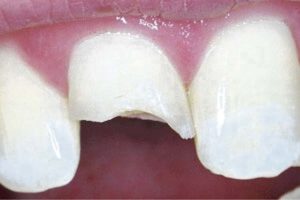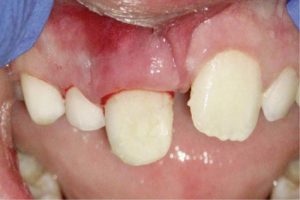Sports injuries and accidents can cause dental traumatic injuries at any age, but these are most common in children and adolescents. Fortunately, the majority of dental injuries are minor to include slightly chipped teeth or bleeding gums. However, some dental injuries can be complex and involve multiple teeth and even bone. In any case, after trauma to the face where the teeth have been injured, an evaluation with a dentist should be scheduled as soon as possible. Millions of teeth are injured or knocked out each year and these teeth can often be saved if quick, appropriate action is taken!

Minor injuries generally involve a chipped tooth or minor bleeding of the gums (picture 1). If the tooth is chipped and there is no bleeding coming from the center of the tooth, a dental appointment within 24-48 hours will suffice. In these situations, it is normal to have some minor sensitivity when touching the tooth and/or sensitivity to hot and cold liquids or foods until the tooth can be treated.
If there is bleeding from the center of the tooth, be sure to have an evaluation and treatment by a dentist as soon as possible. Slightly more pain can be expected in this scenario, which can be treated with over-the-counter ibuprofen (Motrin) or acetaminophen (Tylenol) until treatment is rendered. Avoid touching the tooth and avoid extreme temperature liquids or foods until a dentist can be seen.
If there was a loss of consciousness, bodily injury other than the mouth or if the injured person is confused or dizzy, then take the person to the emergency room before the dentist!

If the tooth is very loose or appears to be in a different position than it was previously (picture 2), an evaluation by a dentist is recommended as soon as possible. While likely painful, an attempt can be made to reposition the tooth to its original position with light to moderate pressure using only a person’s fingers if a dentist is not nearby. Note that this may not be successful, so do not attempt to aggressively force the tooth back into position!
If the whole tooth or part of the tooth has been knocked out, please follow these steps:
- Pick up and hold the whitest part of the tooth. Do not touch the root!
- If the tooth or root is dirty, gently rinse with milk or Pedialyte® (water if neither are available). Do not use any soap or try to scrub the tooth clean!
- If it is a baby tooth, do not put it back in the mouth! If you are unsure, skip to step 5.
- Gently put the tooth back into the socket with only finger pressure. Be sure the smoothest part of the tooth is on the cheek side, not the tongue side. It should look similar to the adjacent tooth/teeth.
- If the tooth cannot be put back into the socket, it needs to be kept moist at all times. Ideally, the tooth should be put in a bottle of Save-a-Tooth®, a liquid sometimes kept by school nurses or sports teams. If this is not available, place the tooth in milk or in the injured individual’s mouth between their teeth and cheek.
Ideally, see a dentist within 30 minutes! If it takes a couple hours, the tooth may still be savable. Don’t forget to bring the tooth!


